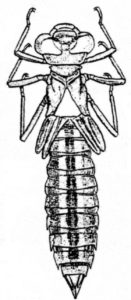by Bonnie Ross
The other day as I was walking to my car, a gleaming object on the hot pavement caught my eye. I bent down and picked up a dead dragonfly that seemed to radiate iridescent colors from its huge eyes, its long, delicate abdomen, and its stained-glass like wings. I decided at once to make this insect the subject of my next “Creek Critter” column.
Dragonflies, along with damselflies, belong to the Order Odonata – from the Greek odont or odous meaning tooth. That’s funny since neither dragonflies nor damselflies have teeth. They do, however, possess an opposable lower jaw which they can project out about a third of their body length to capture prey faster than most of us can blink. Their lower jaws are not the only remarkable adaptation they possess. They are semi-aquatic, spending their adolescence in ponds and slow moving creeks. As nymphs (which look like adult dragonflies without the wings) they usually take two forms. The long aerodynamic type swims after prey. The “tank-like” sturdy form, condensed in shape and usually covered in sediments and organic debris for disguise, wait in ambush for prey to come to them. Their gills are inside their abdomens and they take in water through their anal openings and extract oxygen that way. When chasing down fast prey or escaping larger predators, a dragonfly nymph will squeeze its abdominal muscles, forcing water out and “charging” forward like a balloon flying in circles as the air escapes.

Dragonflies are remarkable aerial predators as well. I have watched a swarm of dragonflies feasting on a swarm of termites. The dragonflies were catching the termites in their basket-like legs, biting off the abdomens and spitting out the wings, thorax and heads. In the water, nymphs feed on anything they can catch from fish and tadpoles to other invertebrates. They no doubt feed on the aquatic larvae of annoying, biting insects like midges and mosquitoes. Although mosquitoes do not lay their eggs in fast moving creeks and streams, they will lay their eggs in back water areas where they are easy prey for these excellent Odonates. By eating mosquitos, dragonflies may even help to control disease and for that reason alone deserve our respect and admiration. Their shimmering beauty enriches our senses.
This article originally appeared in our Fall 2004 Newsletter
